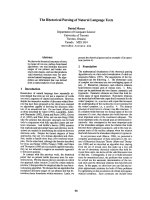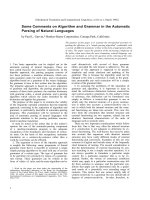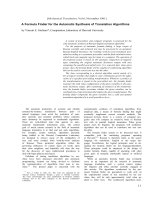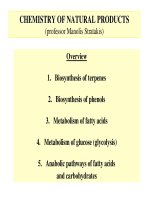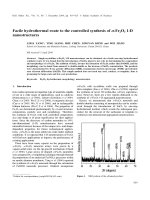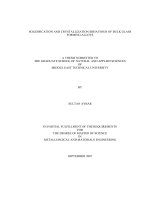Volume 9 the total synthesis of natural products
Bạn đang xem bản rút gọn của tài liệu. Xem và tải ngay bản đầy đủ của tài liệu tại đây (15.14 MB, 540 trang )
THE TOTAL SYNTHESIS
OF NATURAL PRODUCTS
The Total Synthesis
of Natural Products
VOLUME 9
Edited by
John ApSimon
Ottawa-Carleton Institute for Research
and Graduate Studies in Chemistry
and
Department of Chemistry
Carleton University, Ottawa
A WILEY-INTERSCIENCE
PUBLICATION
JOHN WILEY & SONS
NEWYORK
CHICHESTER
BRISBANE
TORONTO
SINGAPORE
A NOTE TO THE READER
This book has been electronically reproduced from
digital information stored at John Wiley & Sons, Inc.
We are pleased that the use of this new technology
will enable us to keep works of enduring scholarly
value in print as long as there is a reasonable demand
for them. The content of this book is identical to
previous printings.
In recognition of the importance of preserving what has been
written, it is a policy of John Wiley & Sons, Inc., to have books
of enduring value published in the United States printed on
acid-free paper, and we exert our best efforts to that end.
Copyright 0 1992 by John Wiley & Sons, lnc.
All rights reserved. Published simultaneously in Canada.
Reproduction or translation of any part of this work
beyond that permitted by Section 107 or 108 of the
1976 United States Copyright Act without the permission
of the copyright owner is unlawful. Requests for
permission or further information should be addressed to
the Permissions Department, John Wiley & Sons, Inc.
Library of Congress Cataloging in Publication Data:
The Total synthesis of natural products.
“A Wiley-Interscience publication.”
Original imprint, v. 1: New York: Wiley-Interscience, 1973.
Includes bibliographical references and indexes.
I . Chemistry, Organic-Synthesis, I. ApSimon, John.
QD262.T655
1973
541l.2
72-4075
ISBN 0-471-03251-4 (v. 1)
ISBN 0-47 1-55 189-9 (v. 9)
10 9 8 7 6 5 4 3 2
I
Contributor
to Volume 9
Kenji Mori, Department of Agricultural Chemistry, The University of Tokyo,
Tokyo, Japan
V
Preface
This volume is a single author effort covering the massive amount of synthetic
work associated with Insect Pheromone Chemistry for the period 1979 to 1990.
Professor Mori has, once more, demonstrated in a masterful way his key position
in this field.
I have been editor of this series since its inception in 1973 and, although I
am convinced of its value to the discipline of organic synthesis, other
responsibilities and interests have slowly intruded, to the state where I must
regretfully pass on the onerous task of keeping the initiative alive to another
editor. Over the past 18 years, I have had the honor of working with many
outstanding authors and scientists. I thank you personally for this collaboration,
friendship, and support.
JOHN APSIMON
Oitawa, Canada
November 1991
vii
Contents
The Synthesis of Insect Pheromones, 1979-1989
KENJIMORI
Subject Index
523
Formula Index
533
ix
The Total Synthesis of Natural Products, Volume9
Edited by John ApSlmon
Copyright © 1992 by John Wiley & Sons, Inc.
The Synthesis of Insect
Pheromones,
1979-1989
KENJI MORI
Depar~menfof Agricultural Chemistry, The Universiry of Tokyo, Japan
1.
2.
3.
4.
5.
6.
7.
8.
9.
10.
11.
12.
13.
14.
15.
16.
Introduction, 2
General Methods, 3
Alkanes as Pheromones, 8
Pheromone Hydrocarbon with a Terminal Double Bond, 15
Pheromone Alcohols and Acetates with an E-Double Bond, 18
Pheromone Hydrocarbons and Acetates with a Z-Double Bond, 25
Pheromone Alcohols and Acetates with a Conjugated Diene and Conjugated Enyne
System, 37
Pheromones with a Nonconjugated Diene System, 66
Phcromones with a Triene or Tetraene System, 79
Pheromones with an Epoxy Ring, 85
Chiral Alcohols and Their Esters as Pheromones, 98
Pheromone Aldehydes, 130
Pheromone Ketones, 157
Acids and Esters as Pheromones, 200
Pheromone Lactones, 2 16
lsoprenoid Hydrocarbons as Pheromones, 273
1
2
The Synthesis of Insect Pheromones, 1979-1989
17. Isoprenoid Alcohols, Formate, Acetates, Propanoates, and Epoxide as Pheromones, 280
18. Isoprenoid Aldehydes, Ketones, Acids, Esters, and Lactones as Pheromones, 332
19. Oxygen Heterocycles (Excluding Epoxides, Lactones, Hemiacetals, and Acetals) as
Pheromones, 367
20. Acetals as Pheromones, 381
21. Spiroacetals as Pheromones, 444
22. Nitrogen Heterocycles and Sulfur-Containing Compounds as Pheromones, 478
23. Conclusion, 484
Acknowledgments, 486
References. 486
1. INTRODUCTION
Since the appearance of the first edition of this chapter in Volume Four of this
series,' a tremendous amount of work has been published in the field of pheromone synthesis. Simple but unique structures that can frequently be seen among
pheromone molecules became favorite targets of synthetic chemists to test their
methodology and strategy in pursuit of simplicity, selectivity, and efficiency.
It is therefore very difficult to write a comprehensive review on pheromone
synthesis. However, it is the aim of this chapter to summarize almost all of the
notable syntheses in the pheromone area published between April 1979 to February 1990. Thus, this chapter will be of service to those chemists who want a
quick view of the existing synthetic methods for each of the individual pheromones.
The pheromones described in this chapter are classified according to the
structural type, as in the first edition. Because the synthesis of optically active
pheromones is now a common practice, enantioselective synthesis has been
included in each section instead of being made into an independent section, The
relationships between absolute configuration and pheromone activity are briefly
summarized at the end of this chapter.
There are a number of recent monographs and reviews on pheromones. The
following brief listing highlights the focus of literature published within the
time frame of this chapter.
A monograph on all aspects of pheromone research-including isolation,
structure determination, synthesis, and estimation of enantiomeric purity-was published in 1984.2
Synthetic methodologies useful in preparing chiral pheromones were thoroughly r e ~ i e w e d . ~
2. GeneralMethods
3
The present status of pheromone biochemistry was compiled as a monograph.4
Three general reviews on insect pheromones become
Ritter reviewed steric factors in pheromonal pest control;8 he also reviewed
his own applied research on semio~hemicals.~
A concise review on chiral insect pheromones was published in Czech. I'
Schneider reviewed the problem of insect olfaction. I'
A comprehensive review became available on structure determination of
pheromones by combined microchemical and gas chromatographic methods.
The following additional reviews were published:
a short reviewI3
an account of the background of pheromone research and its application
in insect pest c o n t r o ~ 'I5
~'
a thorough review covering the literature published in 1982 and 198316
a review on isoprenoid pheromones (in Russian)I7
a pedagogical review on chirality in insect communication18
an account of the pheromone metabolism in insects"
'*
2. GENERAL METHODS
Some useful methods for the synthesis and analysis of pheromones are listed
below.
A. Useful Synthetic Methods
( I ) Alkylation of Acetylides in DMSO
In addition to the existing procedures for the alkylation of 1-alkynes,' Chong
and Wong proposed a method employing methyllithium (base) and DMSO (solvent).*' As shown in Eq. 1, terminal acetylenes afford disubstituted acetylenes
in good yield.
(7747% yield)
R=CH,OTHP, CH,OCH,Ph,
Ph, CH(OEt),
R=n-C,H,,,
n-C,,H,,
Me,CHCH,
X-CI. Br. I
4
The Synthesis of Insect Pheromones, 1979-1989
(2) Alkylation of Acetylides in the Presence of DMPU
Bengtsson and Liljefors employed DMPU (1,3-dimethyl-2-0xohexahydropyrimidine) as a good substitute for the carcinogenic HMPA in the alkylation of
lithium acetylides (Eq. 2).2'
1) n-BuLVTHF
H-CS-(CH,),OTHP
Me(CH,),-C=C-(CH,),OTHP
(91-93%) (DMPU)
(2)
(3) Wittig Reaction in a Heterogeneous Medium
The Wittig reaction can be carried out in a solid-liquid medium under mild
conditions in good yield as shown in Eq. 3.22Wittig chemistry as used in pheromone synthesis was reviewed by Bestmann and V o s t r ~ w s k y . ~ ~
R'-CHO
0.1 rnol
+
'0uo
Ph3PtCH,R2Bi
0.12 rnol
R'=h(CH,),
(100 ml), $CO,
(15 a)
>
HO
, (2 rnl)
(70-73%)
R2=Me(CH,),
Me(CH2),,
'
R1-CH=CH-R2 + Ph,PO
E:2=15-20:80-85
n=10-14
(4) Kolbe Synthesis of Unsaturated Pheromones
Kolbe electrolysis was used for the coupling of 5-alkynic acids and half esters
to give alkynic acids, which could be converted into unsaturated pheromones
(Eq. 4).24
R-C=C-(CH,),CO,H
R=Ef n-Pr, n-Bu
+ HO,C(CH,),CO,Me
n=2,3,4,6
e'
>
~
-2)1) OH'
R-C4-(CH,),+,C02H
(45-59Yo)
(4)
2. General Methods
5
(5) Olefin Inversion
Inversion of the geometry of alkenes is a useful method in pheromone synthes ~ sTreatment
. ~ ~ of alkenes with N-chlorosuccinimide in trifluoroacetic acid results in anti-addition of the element of trifluoroacetyl hypochlorite. Heating the
vic-chlorohydrin trifluoroacetate with sodium iodide in DMF produced alkenes
with inversion of the geometry (Eq. 5).26
(6) Reduction of Diynols to Enynols
2,4-Diyn-l-ols can be reduced to (2E)-en-4-yn- 1-01s by treating the corresponding lithium alcoholates with diisobutylaluminum hydride (Eq. 6).27
1) n-BuU/THF, -8OOC
Me(CH2),C~C-C~C-CH,0H
2) (i-Bu)$lH, -80°C
3) H,O
V
H
Me(CH,),C=C-C=CCH,OH
H
(72%)
(6)
(7) Reduction of Diesters to Diols
Aksenov et al. reported that the preparation of a,o-diols from diesters by reduction with lithium aluminum hydride was made possible in toluene by the
addition of 5-10% of THF, glyme, or diglyme (Eq. 7).28
EtO,C(CH,),CO,Et
LiAIH,
3
toluene +
5-10% THF, glyme
or diglyme
HO(CH,),OOH
(71
6
The Synthesis of Insect Pheromones, 1979-1989
(8) Preparation of w-Bromo-a-alkanolsfrom a, w-Diols
Pure w-bromo-a-alkanols were prepared in good yields by refluxing a mixture
of a,w-diols, 48% hydrobromic acid and benzene using a Dean-Stark water
separator (Eq.
HO(CH,),OH
n =2-12
>
48% HBr/C,H,
reflux (-H,O)
(40-90%)
Br(CH,),OH
(9) Preparation of o-Acetoxy-a-alkanols from a, w-Diols
Monoacetylation of a,w-diols was achieved in high yield by the use of continuous extraction of the reaction mixture consisting of a,w-diols, acetic acid,
water, and sulfuric acid (Eq. 9).30
HO(CH,),OH
n=8, 10, 12
AcOH-H20, H2S04
> AcO(CH,),OH
Continuous extraction with
hexane, cyclohexane or
cyclohexane-CCI,
(75-94%)
(9)
(1 0) Preparation of w-t-Butyldimethylsilyloxy-a-alkanols
from a, w-Diols
McDougal et al. silylated the monosodium alkoxide salt of a,w-diols with one
equivalent of t-butyldimethylsilyl chloride to furnish monosilylated material in
good yield (Eq.
A polymer-supported organosilyl protecting group was
also used in pheromone synthesis.32
HO(CH,),OH
n=21.10
1) leq NaHRHF
2) t-BuSiMe,CI
(77-97%)
>
Me
I
HO(CH,),OSit-Bu
I
Me
(11) Mild Protection and Deprotection of Alcohols as t-Butyl Ethers
t-Butyl ether was found to be the most appropriate protection for o-hydroxyalkyl halides when they were to be converted into organolithium or Grignard
reagents. w-t-Butoxy organolithium and Grignard reagents can be prepared in
ether, exactly like the nonfunctionalized ones, and their reactivity is normal.33
2. General Methods
7
The protection and deprotection of alcohols as t-butyl ethers can be achieved
under the mild conditions exemplified in Eq. 11 .34
ROH
+
3-5eq Ac,O
> ROAc
>
Rot-BU
hexane, room temp
0.1-0.3eqFeCI,
AmberlystH-15
(11)
E$O,2OoC,
2-15hr
3-10 hr
(12) Solid Phase Synthesis
A method different from that developed by Leznoff3’ was devised by Chan and
H ~ a n g . ~They
’ prepared polymer-anchored diphenylchlorosilane and used it for
the protection of the hydroxy group. Equation 12 illustrates its use in the synthesis of (Z)-g-tetradecenyl acetate (fall armyworm moth pheromone).
copolymer (1% crnss-link)
Me(CH,),PPh,B(
Ph
1) (n-Bu),NF/CH,CI,
~io(CHz)8CH-CH(CHz)3Mo2) AczO
Ph
(43% overall)
Other synthetically useful methods are: (1) vitamin B,,-mediated electrochemical reaction^;^^ (2) carbocupration reactions;37 (3) stereodirected synthesis with a-haloboronic
(4) heteroatom-assisted substitution of acyclic
secondary tosylates with lithium dialkyl~uprates;~’
and ( 5 ) semi-hydrogenation
of acetylenes using homogeneous catalysis with (dba)*Pdz* CHCl, * Ar,P, although the ZIE selectivity was poor.4‘
B. Useful Analytical Methods
Reverse-phase TLC and HPLC were shown to be useful for the separation of
pheromone^.^' I3C NMR spectroscopy was employed for the assignment of the
geometry of carbon-carbon double bond(s) of olefinic
Methods were reviewed for determining the enantiomeric purity of pherom o n e ~ . Slessor
~ , ~ ~ et al. described a method for determining the enantiomeric
composition of chiral alcohols, lactones, and hydroxy acids in quantities rang-
8
The Synthesis of Insect Pheromones, 1979-1989
ing from 25 ng to 10 pg.46Derivatization of the substance with enantiomerically
pure acetyllactyl chloride, followed by GLC analysis enables enantiomeric estimation.
3. ALKANES AS PHEROMONES
A. 2-Methylheptadecane 1 (C1BH38)
The title hydrocarbon is the sex pheromone of the tiger moth (Holomelina aurantiaca; Arctiidae species). This achiral alkane was synthesized by Naoshima
employing diethyl 3-oxoglutarate as the starting material (Scheme l).47 Another
synthesis was reported by Bhalerao (Scheme 2).48
Scheme 1
Me(CH2),,CH=CH,
Me
I
> Me(CH,),,CH(CH,),CHCOzMe
1) Hg(0Ac)dAcOH
I
2) CH,=CC02Me
ICI.
OAC
UAIH,
___j
(70%)
3) NaBH,
Me
1) PzOa/CsHE.heal
M~(CH,),,CH(CH~~,~HCH,OH
2) Raney-NirEtOH
AH
> Me(CH2),,CHMeZ
1
Scheme 2
B. (5S,9S)-5,9-Dimethylheptadecane
2 (C 19H40)
The mountain-ash bentwing (Leucoptera scitella) is a pest in the apple orchards
in Hungary. Its female-produced sex pheromone was identified by Francke et
al. as 5,9-dimethylheptadecane (2).49 A synthesis of a diastereomeric mixture
of 2 was achieved by the mixed Koble electrolysis of (*)-3-methylheptanoic
acid and (+)-4-methyldodecanoic acid (Scheme 3) .49
Helmchen’s synthesis of the four stereoisomers of 2 was followed by their
bioassay to reveal (5S,9S)-2, [aID 2.1 (CHCI,) as the natural pheromone.”
+
O
3. Alkanes as Pheromones
.sv\Nv
AZH
'
HOzC
Me3N/MeOH
Pl.elecvod0
0.3Alcrn2,2hr
9
'
(305h)
VdVdNw
(SS.SS).Z
2
Scheme 3
Other stereoisomers neither synergize nor inhibit catches with (5S,9S)-2, and,
therefore, a diastereomeric mixture is practically u ~ e f u l .Another
~ ~ . ~ multigram
~
synthesis of a diastereomeric mixture of 2 was reported by Rama and Capuzzi
(Scheme 4).5'
Scheme 4
C. 3,7-Dimethylnonadecane 3 (C, IH44)
The female-produced sex pheromone of the alfalfa blotch leafminer (Agromyza
frontella) was identified as 3,7-dimethylnonadecane (3).52 A diastereomeric
mixture of 3 was synthesized, as shown in Scheme 5, and shown to be bioactive.
''
Me(CH,), P'P h,Bi
*
Me(CH,),,CH=&(CH,),I
1) ll-&UE$O
a
2) MeC(CH,),CI
PhP
W C
Me
Me
E~=CH(CH,),C=CH(CH,),,Me
I
>
a
Me
Nal
CI(CH~)~~-CH(CH~),~M~
Me
Me(CH2),,CH=C(CH,),P'Ph3l'
I
*
Hpd-C
Scheme 5
1) wBuliTTHF
2)MeSEI
0
Me
Me
I
E~~H(cH,),cH(cH,),,M~
3
10
The Synthesis of Insect Pheromones, 1979-1989
D. 15-Methyltritriacontane4 (C34H70)
This is the female-produced sex-stimulant pheromone of the stable fly (Sromoxys culcitruns). A synthesis of ( f ) - 4 is shown in Scheme 6.53
Two syntheses were reported for the enantiomers of 4. Scheme 7 shows the
synthesis reported by Sonnet.54The chiral part of the molecule was synthesized
via optical resolution. The enantiomeric bromides were then converted to the
cuprates and coupled with tridecyl iodide to give the enantiomers of 4. Their
bioassay results are not yet published.
Naoshima and Mukaidani synthesized the pure enantiomers of 4 in good
overall yield, starting from (I?)-( +)-citronellic acid (Scheme 8 v 3
E. 15,19-Dimethyltritriacontane5 (C35H72)
This alkane is also the mating-stimulant pheromone isolated from female stable
flies (Stornoxys culcitruns). Sonnet prepared (15R,19R)-,(15S,19s)-,and
meso-5 (Scheme 9).54The starting chiral alcohol was obtained by resolution in
the same manner as shown in Scheme 7.
3. Alkanes as Pheromones
Me(CH,),CH-PPh,
(92%)
(Iss,les).5
Scheme 9
11
I2
The Synthesis of Insect Pheromones, 1979-1989
F. rneso-15,23-Dimethylpentatriacontane
6 (C37H76)
The title compound is the sex-stimulant pheromone of the female tsetse fly
(Glossina palfidipes).A simple synthesis of a diastereomeric mixture of 6 was
reported by Carlson et al. (Scheme lo)? Both the enantiomers of 6 , as well as
Scheme 10
meso-6, were synthesized from (I?)-( +)-citronelk acid, employing the alkylation of the dianion derived from methyl acetoacetate as the key-step (Scheme
1 l).56 Only meso-6 was shown to be b i ~ a c t i v e . ~ ~
(13R,23R)-B
(13S.23S)B
(25% overall yield)
(37% overall yield)
mp 45-46.5OC
mp M.s-~E~'c
[a],,=
-0 26' (CHCi,) [a],,"
+0.25°(CHC13)
mesod
(59% l r m (R)-Bl
mp 34-34.5'~
Scheme 11
3. Alkanes as Pheromones
G. meso-17,21-Dimethylheptatriacontane 7
13
(C39H80)
This is the female-produced sex-stimulant pheromone of the tsetse fly (Glossina
morsitans morsitans). All of the three possible stereoisomers were synthesized
by Helmchen (Scheme 12).5s The enantiomers of A were synthesized either by
Me(CH,),,AC02H
+
HzN\rOH
Ph
(1 7R.21 R)-7, (17S,215)-7
and meso-7
meso-7
Scheme 12
optical resolution or by asymmetric alkylation. By combining the enantiomers
of A, (17R,21R)-, (17S,21S)-, and meso-7 were prepared. Only the meso-isomer was shown to be b i o a ~ t i v e . ~ ~
H. 15,19,23-Trimethylheptatriacontane8 (C40H82)
The title compound is also the sex-stimulant pheromone isolated from the female tsetse fly (Glossina morsitans morsitans). Two new syntheses of its dias-
14
The Synthesis of Insect Pheromones, 1979-1989
tereomeric mixture were
In the earlier synthesis, geranyllinalool
(A) was converted to a symmetrical intermediate B, the chain elongation of
which by a Wittig reaction completed the construction of the carbon skeleton
(Scheme 13).60 Naoshima et al. utilized diethyl 3-oxoglutarate as their symmetrical building block to obtain a diastereomeric mixture of 8 (Scheme 14).6’
8
Scheme 13
0
WCH,),,
&OMS
loluene
1
(CH2)13Me
NaOH aq
(33%)
4. Pheromone Hydrncarbon with a Terminal Double Bond
15
4, PHEROMONE HYDROCARBON WITH A TERMINAL
DOUBLE BOND
A. (S)-14-Methyl-l-octadecene 9 (CI9H3*)
The title compound 9 was isolated and identified as the sex pheromone of the
peach miner moth (Lyonetia clerkella), which is one of the destructive pests in
the peach orchards of Japan. The first synthesis of (*)-9 was executed at the
time of its isolation for the purpose of identification.62 That synthesis is lengthy
and inefficient (Scheme 15).62Two more efficient syntheses of (k)-9were pub-
-
HO(CH,),,OH
>
-HBr
HO(CH,)12Br
Ph P
A>HO(CH,)l,P’Ph,Br~
1) base
1) NH
, *,
H20,
2) Me(CH,),COMe
2) CrO,*C,H,N’
Scheme 15
lished later by chemists in industry. Manabe et al. introduced the double bond
of (*)-9 at the final stage of their synthesis (Scheme 16),63 while Yamamoto
dgBr
+
48%HBr
(89%)
Br(CH,),,OTHP
1) Li,CuCI,/THF
2) TsOH/aq MeOH
(77%)
Br
t-BuOK
DMSO
(55%)
>
(k)-9
Scheme 16
and Fukumoto used ally1 chloride as one of their starting materials (Scheme
17).64
Four different syntheses of optically active 9 were reported. In Mori’s first
synthesis, the enantiomers of methyl 0-hydroxyisobutyrate (A) were employed
as the chiral building blocks (Scheme 18).65 A is of microbial origin and com-
The Synthesis of Insect Pheromones, 1979-1989
16
Scheme 17
A
TsCl
(98%)
2) TSOHN~OH
(72%)
3) TsCl
1) m
g
Li,CuCI,TTHF
B
r
>
2) SiO,-AgNO, chromatog.
(9-14%)
(S)-9
[alO2'
+1 .21° (n-hexane)
(R)-9
[a],*'-1.06' (n-hexane)
Scheme 18
mercially available. In the final step of the synthesis, however, the yield was
quite modest due to the difficulty in separating 9 from other hydrocarbons generated as byproducts.
(R)-(
+)-Citronellic acid was used as the starting material in the second synthesis of (R)-9 and (S)-9 (Scheme 19).66Only (S)-9 exhibited the pheromone
activity, although (f)-9 was also active.67
The third synthesis by Sonnet et al. was based on the optical resolution of
an intermediate (Scheme 20).68
Serebryakov converted (S)-( +)-3,7-dimethyl-l,6-octadiene into (S)-9
(Scheme 21).69
4. Pheromone Hydrocarbon with a Terminal Double Bond
1) Me,CuLl
1) TsCl
2) NaOH
(76%)
(W-9
(70%)
[a]:' -1.24' (n-haxane)
(65%)
(75%)
Scheme 19
1) LDA
EtCO,H
2) Me(CH2),B?
(94%)
,&
1)LDA.
2) wnc HCI
3)UAIH,
(88%)
'
&H
1) SOCI,
2) H,NCH(Me)Ph
Tco2H
3) Recryslallizallo"'
4
N
h
\
P
h
(40%)
1) Ph,PBr,
2) Nal, Ph,P
>w
i
P ' P h , l '
Scheme 20
1) n-BuU
>
2) OHC(CH2),,OTHP
(67%)
17
18
The Synthesis of Insect Pheromones, 1979-1989
1) 5G% AcOH
2)HIO.
3j N ~ H ,
(eo%)
1) TsCl
2) MeMgI, LI,CUCI,~THF
(78%)
>
(59-9
[a]Op
4.6' (CHC13)
Scheme 21
5. PHEROMONE ALCOHOLS AND ACETATES WITH AN
E-DOUBLE BOND
A. (E)B-Nonen-1-01 10 (C9HI80)and (E)d-Nonenyl Acetate 11
(C I I H2002)
Males of the Medit'erranean fruit fly (Cerariris capitafa) produce (E)-6-nonen1-01 10 as the sex pheromone. The corresponding acetate 11 is the attractant
for the female melon fly (Dacus cucurbitae).
A Wittig-Homer reaction was employed to furnish 10 (Scheme 22).70*7'
\J'
0
(81%)
NaH
DMF
(98%)
'
,H
c, = c,
ti
Scheme 22
10
(CH2150H



